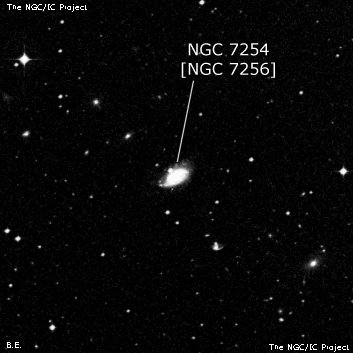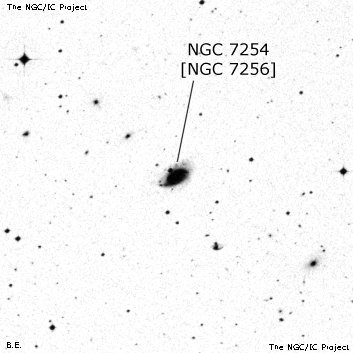NGC/IC Project Restoration Effort
(This is a very very beta version)
NGC7254


Basic Information
Location and Magnitude
Right Ascension: 22:22:36.0
Declination: -21:44:5
Constellation: AQR
Visual Magnitude: 13.2
Historic Information
Discoverer: Muller
Year of discovery: 1886
Discovery aperture: 26.3
Observational
Summary description: vF, vS, R, * 11 p 4'.5
Sub-type: SBb
Corwin's Notes
=====
NGC 7254 = NGC 7256. Herbert Howe made this identification in the late 1890s.
Here is what he had to say in his note in MN 63, 356, 1898:
These are identical. The place of 7254 is wrong in right ascension, and the
place of 7256 is wrong in declination. I could find only one nebular object
in this vicinity. Two of the three faint stars involved, and mentioned by
Marth were seen; the third was suspected. The northern most one was
brightest, and was of mag. 14. The 11 mag. star which Muller saw 4.'5
preceding the nebula was also observed. The position is 22h 17m 06s, -22d
14.'5 [for 1900.0]."
It remains for me to say that Marth's description reads "3 ** involved in F
nebulosity", and that he observed the object at least twice -- his date,
1864.74, is marked "ver", meaning that he verified the nebula. So, his
declination, exactly 10 arcmin south of the true position, must be a simple
transcription error. His notation "3 **" is interpreted by both Dreyer and
Howe to mean "three stars" rather than "three double stars". Given the two
stars superposed on the galaxy and its nucleus, this makes sense.
Muller's RA is about 30 seconds of time too far west, but his measurement of
the companion star ("P[A] 280d, [distance] 4.'5") is accurate and pins down
the object that he saw.
Steve's Notes
=====
NGC 7254
See observing notes for NGC 7256.



